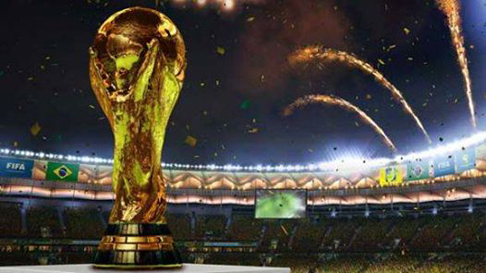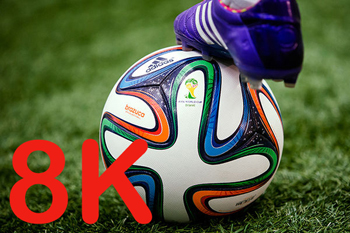4K, 8K Production Shows Maturity At World Cup

Fraunhofer’s HD OmniCam provided a unique perspective on the games final match.
RIO DE JANEIRO—Along with the massive amount of coverage in high definition, production workflows for this year’s World Cup tournament might best be remembered for advancing the use of higher resolution images into the mainstream. All of the processes and techniques have not yet been fully worked out, but events like the World Cup are the perfect place to experiment.
And there was a lot of experimenting to do, as FIFA oversaw the delivery of some 5,000 hours of live content (including the 64 matches and a multitude of related programming).
FIFA TV, HBS, Sony, and NHK all had a hand in making sure production teams from around the world had what they needed to produce some of the most stunning footage of a live sporting event ever seen. Sony’s F55 4K cameras were seen throughout the various venues, as Sony helped produce the Official 2014 FIFA World Cup Film in 4K Ultra HD, as well as three full matches in 4K to, it said, "further promote the growth of 4K content.”

During the World Cup Sony provided a large complement of equipment and served as an official sponsor, aggressively marketed its 4KTV products. Sony 4K equipment—including its PMW-F55 CineAlta 4K live camera, PWS-4400 4K multiport AV storage unit, PVM-X300 4K LCD monitors and MVS-7000X 4K multiformat switchers—was seen virtually everywhere and helped cover one match from the round of 16 (June 28), one quarter-final (July 4th), and the final (July 13) at the Estadio Maracanã in Rio de Janeiro. In addition to equipment, Sony provided technical support to FIFA. Much of the 4K footage will be compiled into the Official 4K Film in the coming months.
“We are very excited to offer an entirely new viewing experience at the greatest sport event in the world, the FIFA World Cup,” said Soichi Kawachi, vice president in charge of the FIFA Partnership at Sony. “By leveraging our cutting-edge 4K technology and our premier products and solutions through our partnership with FIFA, we [delivered] a unique and totally compelling entertainment experience, conveying the excitement of the matches in Brazil with the depth and vividness that the ultra-high definition of 4K delivers.”
Several production professionals in Brazil reported that crews are becoming more familiar with the techniques and best practices required with 4K gear, including understanding how to pan an entire soccer pitch with a telephoto lens while avoiding capturing images that are blurry and contain other types of aliasing. Some said increasing the frame rate during recording helps in this area.
The professional video industry's #1 source for news, trends and product and tech information. Sign up below.
Another of the lessons learned was the proper placement of camera within a venue. In general, 4K cameras want to be as close to the field of play as possible (some cameras were used handheld on the field).
Meanwhile, Japanese national broadcaster NHK was on hand in Brazil aggressively promoting its Super Hi-Vision 8K recording system (complete with an NEC production switcher, Astrodesign and EVS instant replay servers and 22.2 channels of digital audio). All of the video equipment was housed in a 53-foot production trailer, which was used to produce nine matches in 8K and then transmitted back to Japan. Audio was mixed on site (in most cases downmixed to 5.1 surround sound for easy consumer consumption) in another soundproof trailer.

NHK continues to push the boundaries of 8K resolution images for live sports and entertainment production. The 8K productions involved three Ikegami cameras—two with Canon 10x lenses and the third using a Fujinon 11x lens—plus three 4K cameras: a Sony F65 camera to shoot live features outside of the stadium and two For-A Corp. FT1 native 4K super slow motion cameras. The ability to shoot close-ups in 8K with image anomalies continues to be problematic, according to an NHK technician.
Of note: a 360-degree camera developed by Germany-based Fraunhofer Heinrich Hertz Institute, called the “Ultra HD OmniCam,” was tested during the final match in Rio de Janeiro. Positioned at the halfway line of the pitch, the OmniCam was used to record the complete stadium in one panoramic view.
“Immersive video services will play an important role in the future and football is one of the most attractive applications for such kind of technology,” said Dr. Ralf Schäfer, from the Fraunhofer Heinrich Hertz Institute.
Another German company, GoalControl, mounted 14 high-speed cameras—seven per goalmouth—to the roof of each of the 12 World Cup stadiums. These are connected to an image-processing computer that filters out non-ball-shaped objects and tracks the ball’s position to within a few millimeters, the company said.

When the ball crosses the goal line, the system sent a vibration to the referee’s watch and the word “GOAL” appears on his screen, all in less than a second.
